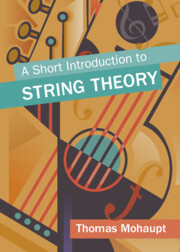Book contents
- Frontmatter
- Dedication
- Contents
- Preface
- Acknowledgements
- Introduction
- Part I From Particles to Strings
- Part II TheWorld-Sheet Perspective
- Part III The Space-Time Perspective
- Part IV Outlook
- 12 Interactions
- 13 Dimensional Reduction and T-Duality
- 14 Fermions and Supersymmetry
- Appendix A Notation and Conventions
- Appendix B Units, Constants, and Scales
- Appendix C Fourier Series and Fourier Integrals
- Appendix D Modular Forms and Special Functions
- Appendix E Young Tableaux
- Appendix F Gaussian Integrals and Integral Exponential Function
- Appendix G Lie Algebras, Lie Groups, and Symmetric Spaces
- References
- Index
14 - Fermions and Supersymmetry
from Part IV - Outlook
Published online by Cambridge University Press: 31 March 2022
- Frontmatter
- Dedication
- Contents
- Preface
- Acknowledgements
- Introduction
- Part I From Particles to Strings
- Part II TheWorld-Sheet Perspective
- Part III The Space-Time Perspective
- Part IV Outlook
- 12 Interactions
- 13 Dimensional Reduction and T-Duality
- 14 Fermions and Supersymmetry
- Appendix A Notation and Conventions
- Appendix B Units, Constants, and Scales
- Appendix C Fourier Series and Fourier Integrals
- Appendix D Modular Forms and Special Functions
- Appendix E Young Tableaux
- Appendix F Gaussian Integrals and Integral Exponential Function
- Appendix G Lie Algebras, Lie Groups, and Symmetric Spaces
- References
- Index
Summary
We use the the supersymmetric harmonic oscillator to introduce supersymmetry, and to motivate how world-sheet supersymmetry leads to space-time fermions. After a short review of Poincaré Lie superalgebras, we introduce the RNS-model, both as an example of a supersymmetric field theory and as a stepping stone to type-II superstrings. We motivate the GSO-projection through modular invariance and show how the massless spectra as well as the D-branes of type-II string theories arise. Type-I and heterotic strings are briefly introduced, and we conclude with an overview of the dualities that relate the five modular invariant supersymmetric string theories to one another, and to eleven-dimensional M-theory.
Keywords
- Type
- Chapter
- Information
- A Short Introduction to String Theory , pp. 215 - 238Publisher: Cambridge University PressPrint publication year: 2022

